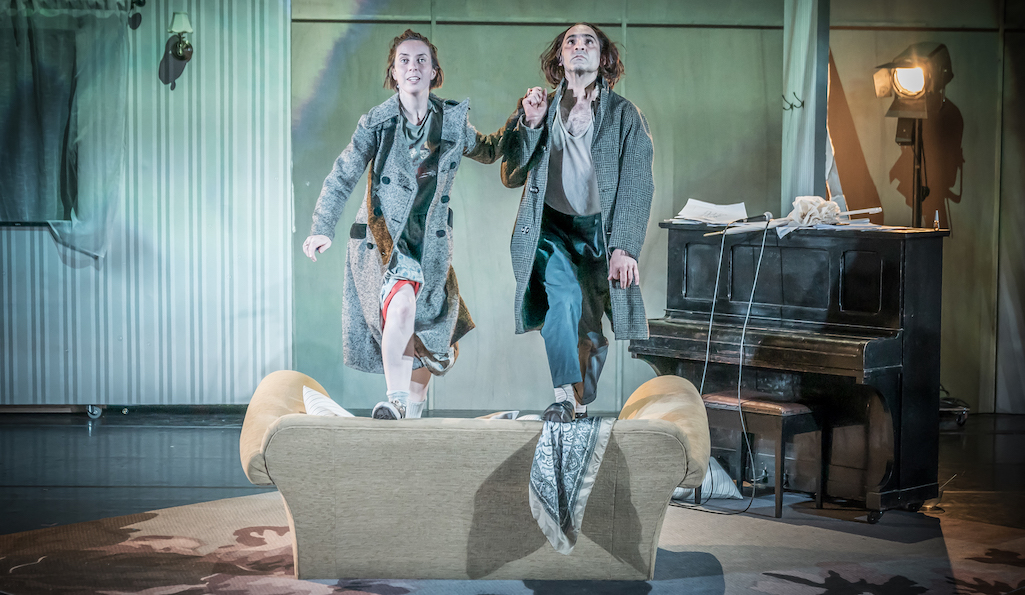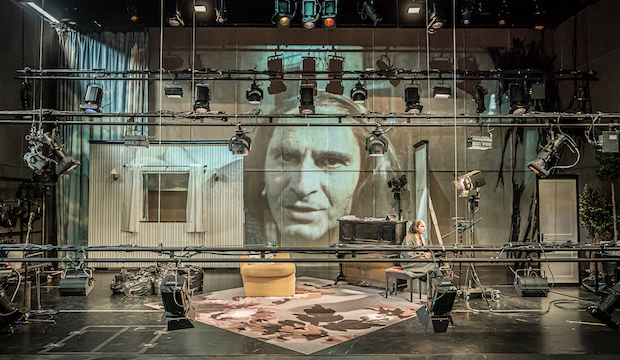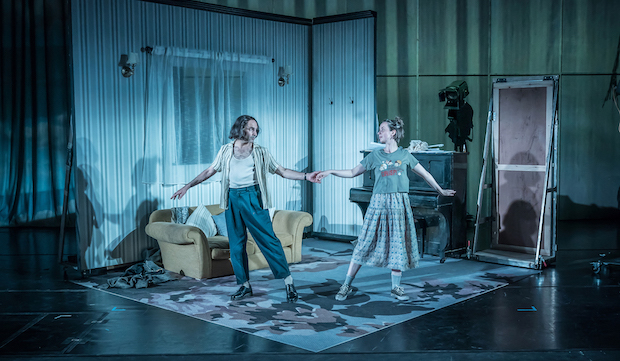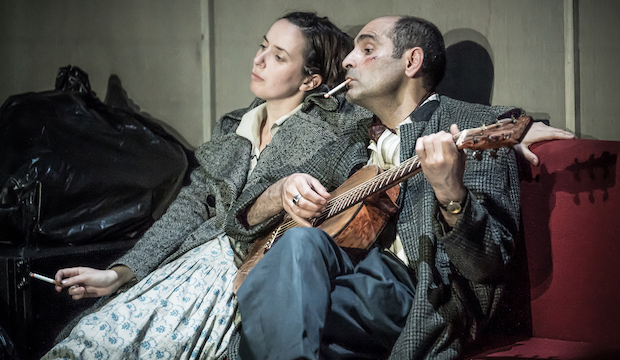The Two Character Play, Hampstead Theatre review ★★★★★
It may have arrived two years later than planned, but Sam Yates’ technologically apt take on The Two Character Play finds special resonance in post-lockdown London
The Two Character Play. Photo: Kate O’Flynn, Zubin Varla. Credit: Marc Brenner
‘Everything in his life is in his plays and everything in his plays is in his life,’ said American director Elia Kazan of Tennessee Williams’ work. So is true of The Two Character Play, in which siblings Felice and Clare could well be Williams and his mentally troubled sister Rose in an alternate reality in which the writer stayed home instead of leaving her to find success on the page.
In the hands of director Sam Yates, The Two Character Play is revived at Hampstead Theatre, the site of its world premiere in 1967 – where it became the only one of Williams’ plays to premiere outside the US. Fuelled by brilliant use of technology and masterful performances from Zubin Varla (Ghost Quartet, Fun Home) as Felice and Kate O’Flynn (Blank, The End of History) as Clare, the production triumphs.

Kate O’Flynn and Zubin Varla in The Two Character Play. Photo: Marc Brenner
The story follows two sibling actors, Felice and Clare, who have been deserted by the rest of their troupe, but remain haughtily determined to perform their two-hander (also called The Two Character Play) in front of an audience already taking their seats in the auditorium.
The ensuing plot flits between the siblings’ real-life dramas of staging a play neither of them are fully on top of – nor have the full set, costumes and props to perform – and their aimless play-within-a-play, set in the deep south of America. In Yates’ production, only the comedic drawl of the pair's southern accents helps the audience navigate between the two fictional worlds. As we're drawn deeper into the intentionally muddled narrative, the toxic co-dependence of the pair and their uncomfortable familial relationship with one another becomes more apparent.

Photo: Marc Brenner
Using the creative potential of this multilayered play is a skilful backstage team. Akhila Krishnan’s videography projects up-close footage of the duo on a giant screen at the back of the stage, and later takes us eerily inside Clare’s childhood memories. Rosanna Vize’s production design, including low-strung lighting rigs and a flimsy-looking set, coupled with Lee Curran’s lighting, reminds us we are watching a play within a play. As the siblings struggle to keep their audience enrapt, Dan Balfour’s genius sound design uses hidden speakers to fill the auditorium with the coughs, laughs and whispers of the internal play’s invisible audience to chilling effect.
The production has arrived on stage two years later than scheduled, and yet the sheer buffoonery of The Two Character Play finds a special resonance in post-lockdown London, with Yates capitalising astutely on the farce currently faced by the theatre industry, with performances called off as a result of cast and crew members being forced to isolate.

Zubin Varla and Kate O’Flynn. Photo: Marc Brenner
This irony is chewed over deliciously by Varla, who takes his time over Felice’s speech informing the audience of the wider company's absence. ‘Of course there have been some, a number of, unexpected difficulties,’ he spits, emphasising each word to knowing chortles from the audience. As he goes on to comment: ‘our company has been delayed by, um, transportation difficulties due to the eccentricities of the time,’ it’s all too easy to substitute the performers walking out for the dreaded ping-demic currently plaguing the theatre industry.
The play’s earlier comic sparkle – a fusion of immaculately-timed slapstick and subtler witty moments such as an overly twee harmony (credit to Varla and O’Flynn’s pitch-perfect singing) or the picking up of an invisible prop on a largely naturalistic set – gives way to something altogether more nightmarish once the pair are left without an audience and the drama envelopes us in the tormenting circus of Rose’s mind.

Kate O’Flynn and Zubin Varla. Photo: Marc Brenner
More desperate, still, are the final throes of the narrative, in which Felice and Clare choose to climb back inside the play with no ending, where the presence of a gun looms over their life. In painting a claustrophobic existence of waiting for callers and blowing soap bubbles, Williams hints at what may have become of him and Rose had he remained begrudgingly by her side.
The Two Character Play may have arrived two years later than planned, but Yates’ technologically apt take on the drama packs a greater punch at a time when the theatre industry is recovering from the pandemic. As the stage lights dim and the pair realise they’re trapped inside a theatre that's locked from the outside, you can’t help but think of the ghostly echoes of productions past, haunting the theatres each night with no audiences to entertain during the lockdown.
In the hands of director Sam Yates, The Two Character Play is revived at Hampstead Theatre, the site of its world premiere in 1967 – where it became the only one of Williams’ plays to premiere outside the US. Fuelled by brilliant use of technology and masterful performances from Zubin Varla (Ghost Quartet, Fun Home) as Felice and Kate O’Flynn (Blank, The End of History) as Clare, the production triumphs.

Kate O’Flynn and Zubin Varla in The Two Character Play. Photo: Marc Brenner
The story follows two sibling actors, Felice and Clare, who have been deserted by the rest of their troupe, but remain haughtily determined to perform their two-hander (also called The Two Character Play) in front of an audience already taking their seats in the auditorium.
The ensuing plot flits between the siblings’ real-life dramas of staging a play neither of them are fully on top of – nor have the full set, costumes and props to perform – and their aimless play-within-a-play, set in the deep south of America. In Yates’ production, only the comedic drawl of the pair's southern accents helps the audience navigate between the two fictional worlds. As we're drawn deeper into the intentionally muddled narrative, the toxic co-dependence of the pair and their uncomfortable familial relationship with one another becomes more apparent.

Photo: Marc Brenner
Using the creative potential of this multilayered play is a skilful backstage team. Akhila Krishnan’s videography projects up-close footage of the duo on a giant screen at the back of the stage, and later takes us eerily inside Clare’s childhood memories. Rosanna Vize’s production design, including low-strung lighting rigs and a flimsy-looking set, coupled with Lee Curran’s lighting, reminds us we are watching a play within a play. As the siblings struggle to keep their audience enrapt, Dan Balfour’s genius sound design uses hidden speakers to fill the auditorium with the coughs, laughs and whispers of the internal play’s invisible audience to chilling effect.
The production has arrived on stage two years later than scheduled, and yet the sheer buffoonery of The Two Character Play finds a special resonance in post-lockdown London, with Yates capitalising astutely on the farce currently faced by the theatre industry, with performances called off as a result of cast and crew members being forced to isolate.

Zubin Varla and Kate O’Flynn. Photo: Marc Brenner
This irony is chewed over deliciously by Varla, who takes his time over Felice’s speech informing the audience of the wider company's absence. ‘Of course there have been some, a number of, unexpected difficulties,’ he spits, emphasising each word to knowing chortles from the audience. As he goes on to comment: ‘our company has been delayed by, um, transportation difficulties due to the eccentricities of the time,’ it’s all too easy to substitute the performers walking out for the dreaded ping-demic currently plaguing the theatre industry.
The play’s earlier comic sparkle – a fusion of immaculately-timed slapstick and subtler witty moments such as an overly twee harmony (credit to Varla and O’Flynn’s pitch-perfect singing) or the picking up of an invisible prop on a largely naturalistic set – gives way to something altogether more nightmarish once the pair are left without an audience and the drama envelopes us in the tormenting circus of Rose’s mind.

Kate O’Flynn and Zubin Varla. Photo: Marc Brenner
More desperate, still, are the final throes of the narrative, in which Felice and Clare choose to climb back inside the play with no ending, where the presence of a gun looms over their life. In painting a claustrophobic existence of waiting for callers and blowing soap bubbles, Williams hints at what may have become of him and Rose had he remained begrudgingly by her side.
The Two Character Play may have arrived two years later than planned, but Yates’ technologically apt take on the drama packs a greater punch at a time when the theatre industry is recovering from the pandemic. As the stage lights dim and the pair realise they’re trapped inside a theatre that's locked from the outside, you can’t help but think of the ghostly echoes of productions past, haunting the theatres each night with no audiences to entertain during the lockdown.
TRY CULTURE WHISPER
Receive free tickets & insider tips to unlock the best of London — direct to your inbox
| What | The Two Character Play, Hampstead Theatre review |
| Where | Hampstead Theatre, Eton Avenue, Swiss Cottage, London, NW3 3EU | MAP |
| Nearest tube | Chalk Farm (underground) |
| When |
17 Jul 21 – 28 Aug 21, Performances at 19:30pm with additional 2:30pm matinees |
| Price | £16 - £37 |
| Website | Click here for more information and to book |